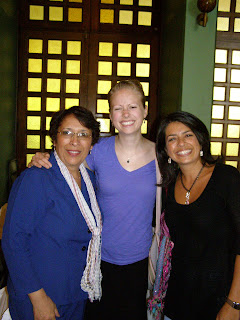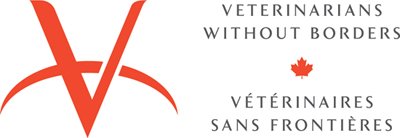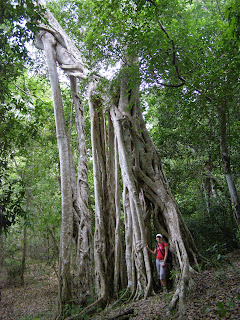My last week in Guatemala was spent at the home of Dra de Romillo while visiting the Faculty of veterinary medicine of the University of San Carlos. This is the only vet school in Guatemala, and is considered to be the leading school in Central America. While there, I visited the department of Public Health and spent a good amount of time at the teaching hospital. I met with Dra Andrea Portillo who is responsible for organizing sterilization campaigns in different areas of the country with the students, as well as the Dean of the faculty. It was encouraging to see the high level of interest on behalf of the faculty to continue to form bonds with the FMV in Montreal and to work on building a long-term exchange program between the two schools.

I left Guatemala on Monday to spend a day in Costa Rica to meet with WSPA (World Society for the Protection of Animals), and confirmed their interest in collaborating in the production on the rabies education manual.
And after 3 more flights and an uncomfortable night in Washington National airport, it was wonderful to be greeted home in Montreal!
To sum it all up: 10 weeks, 1 dog population survey, 1 rabies surveillance report, and 1 dog bite and rabies prevention manual. Uncountable Spanish mistakes, but with huge improvement. Nights spent sleeping under 5 blankets, 2 sleeping bags and a toque in Todos Santos, and nights spent sleeping in not very much, in a tent in the jungle. 2 new families, lots of new friends, and some great connections. Over 200km of hiking between the Cuchumatanes mountains and the Peten jungle, and lots of hours at the computer. Some late nights in surgery, some quiet days of reading, some days in meetings (sometimes in appropriate attire, others in hiking boots) and some air time on Xela TV and radio. Getting to know a country where the way of life varies enormously between individuals and cultures, but where generosity and hopsitality is always in the cards.

I feel so lucky to have had this opportunity, and can't thank enough everyone who helped make it such a great experience. Thanks to my hosts in Guatemala (Dr. Dugas, the Cajas-Morales family and the de Romillo family), Dr. Dugas for supervising my time at PAHO, Dr. Figueroa for giving me the chance to work with him in Xela, and Dra de Romillo for organizing my time at the faculty. My project was made possible thanks to Vets Without Borders Canada (thank you Enid, Marjo, Andrew and Kate!) le Groupe International Veterinaire of U of M (thank you Denise, Kathleen, Cecile and Josiane), and grant from the Millennium Scholarship Foundation. And finally, thanks to everyone in Guatemala who gave me such a wonderful welcome.
And thank you for reading, hope you enjoyed!
***
Durant ma dernière semaine au Guatemala, j’étais logée chez Dre de Romillo pour visiter la Faculté de médecine vétérinaire de l’Université de San Carlos. C’est la seule faculté vétérinaire dans le pays, et est reconnue partout en Amérique centrale. Pendant que j’étais là, je visitais le département de santé publique et je passais beaucoup de temps à l’hôpital d’enseignement. J’ai rencontré Dre Andrea Portillo qui est la responsable pour les cliniques de stérilisation qui sont effectués avec les étudiants, ainsi que le doyen de la faculté. J’étais très encouragée de voir un fort intérêt de la part de la faculté de continuer de travailler à faire des liens avec la FMV et de créer éventuellement un stage plus permanent entre les deux facultés.

Je suis partie du Guatemala lundi matin pour passer la journée à Costa Rica en rencontrant le WSPA (World Society for the Protection of Animals) pour confirmer leur implication dans la production du livre éducatif.
Finalement, après 3 autres vols et une nuit plutôt inconfortable dans l’aéroport de Washington D.C., c’était très agréable d’être rencontrée à mon arrivée à Montréal!
Pour faire le bilan : 10 semaines, 1 sondage de population canine, 1 sommaire de la surveillance de la rage et un bouquin éducatif sur la prévention des morsures et de la rage. Des fautes innombrables d’espagnol, mais beaucoup de progrès. Quelques nuits dormant sous 5 couvertes, 2 sacs de couchage et une toque à Todos Santos, et quelques nuits dormant peu vêtue dans une tente dans la jungle. 2 nouvelles familles, plusieurs nouveaux amis et de très belles connections. Plus de 200km de randonnée entre les montagnes Cuchumatan et la jungle de Petén, et plusieurs heures à l’ordi. Quelques longues nuits de chirurgie, quelques jours tranquilles de lecture, quelques jours en réunion (des fois bien habillée, d’autres fois en bottes de randonnée) et passant à la télé et au radio à Xela. Découvrir un pays dans lequel la population connaît une variété énorme de styles de vie, mais où l’hospitalité est toujours au menu.

Je me sens très chanceuse d’avoir eu cette opportunité, et je ne peux pas remercier assez tout le monde qui a contribué à me donner une expérience si mémorable. Merci à tous qui m’ont hébergé au Guatemala (Dr Dugas, la famille Cajas-Morales et la famille de Romillo), Dr Dugas de m’avoir supervisé à PAHO, Dr. Figueroa de m’avoir donné la chance de travailler avec lui à Xela et Dre de Romillo d’avoir organisé mon séjour à la Faculté. Mon projet a été possible grâce à Vétérinaires sans Frontières Canada, (merci à Enid, Marjo, Andrew et Kate), le Groupe International Vétérinaire de la FMV (merci à Denise, Kathleen, Cécile et Josiane), ainsi qu’une bourse du Millénaire. Finalement, j’aimerais remercier tout le monde au Guatemala de m’avoir si bien accueilli.
Et merci à vous d’avoir suivi mon voyage, en espérant que vous avez aimé l’expérience!




